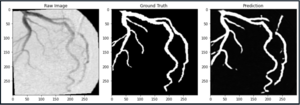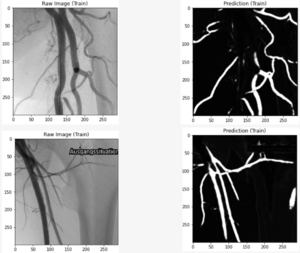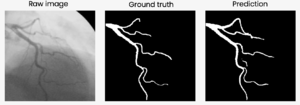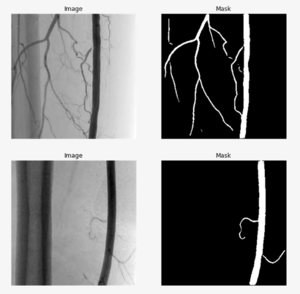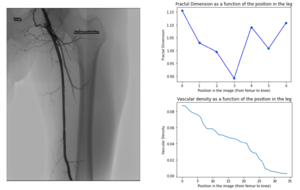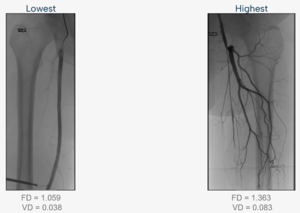Vascular properties of patients with peripheral artery disease
Project by Marius Audenis, Gabriel Chiche, Léo Besançon and Nuno Ribeiro Galheto
Supervisor: Michael Beyeler
Link to the presentation: Media:XraySeg.pptx
Introduction:
Peripheral artery disease is a condition where these arteries, usually in your legs, become narrowed or blocked by fatty deposits buildup. This plaque is made up of cholesterol, fat, calcium, and other substances found in the blood. As the arteries narrow, blood flow to the legs and feet is reduced and this restricted blood flow can cause symptoms like leg pain, cramping, and even difficulty walking. If left untreated, it can lead to serious complications like non-healing wounds and even limb amputation. Treatment of moderate PAD includes correction of vascular risk factors and physical exercise. Severe PAD usually requires angioplasty (open blocked artery) or surgical bypass, or even amputation.
That’s why it is very important to prevent this disease, and this is where our research comes in. We can use Segmented X-ray angiograms.
These are essentially detailed images of your blood vessels obtained by injecting a contrast dye and taking X-ray images. However, interpreting these images can be challenging and it often requires a lot of time and expertise.
So, we have developed an algorithm that can analyze these X-ray angiograms and segment the areas of narrowing or blockage in the arteries. By doing this, we aim to provide a more precise and efficient way of diagnosing and assessing the severity of PAD.
It can potentially lead to earlier detection of PAD, allowing for interventions before the condition progresses to more serious stages and it’s also important to give patients the most appropriate treatment depending on the disease.
Methodology:
We started our project by recreating a U-Net architecture ourselves, based on Pytorch. We also used a more advanced architecture, the nn-Unet. We trained both models with our training dataset that was composed of 134 pictures of coronary angiograms, with for each image its ground truth outlined by an expert cardiologist. The dataset of interest was supposed to be sent by the hospital but was delayed so we worked with only 15 bad quality screenshots of legs angiograms.
Results:
Below are the predictions made by the U-Net model we built from scratch, both on training data and testing data, i.e. the leg angiograms. When looking for systematic errors, we see that the model tends to make the smaller blood vessels bigger while failing to pick up correctly the larger vessels. The mean validation DICE loss for this model was 0.45.
Now, we can look at the predictions made by the nn-UNet, again on the same training and testing sets. We see that the systematic errors found in the previous model are not present here and that the model performs pretty well on unseen data. The mean validation DICE loss here was 0.20.
Using the masks built by the nn-UNet, we then calculated fractal dimension and vascular density for the images in our testing dataset. Below are two examples those measurements, expressed as a function of the position in the leg with the reference image.
Finally, here is the images with both the highest and lowest fractal dimention and vascular density. Interestingly, we can note that these images have bothes the highest or lowest value for the two measures, which means they might be correlated. This makes sense, as an artery with lower fractal dimension means it branches out less, so there are less vessels and so the vascular density is lower.
